What’s a fun and easy science experiment for kids? Dissolving candy! Anything having to do with candy is a treat, and there’s plenty of science to be learned setting up this simple experiment for quick chemistry, including solutes and solvents. Grab the free printable science journal page too. Get ready to set up this incredibly simple and fun science activity for kids!
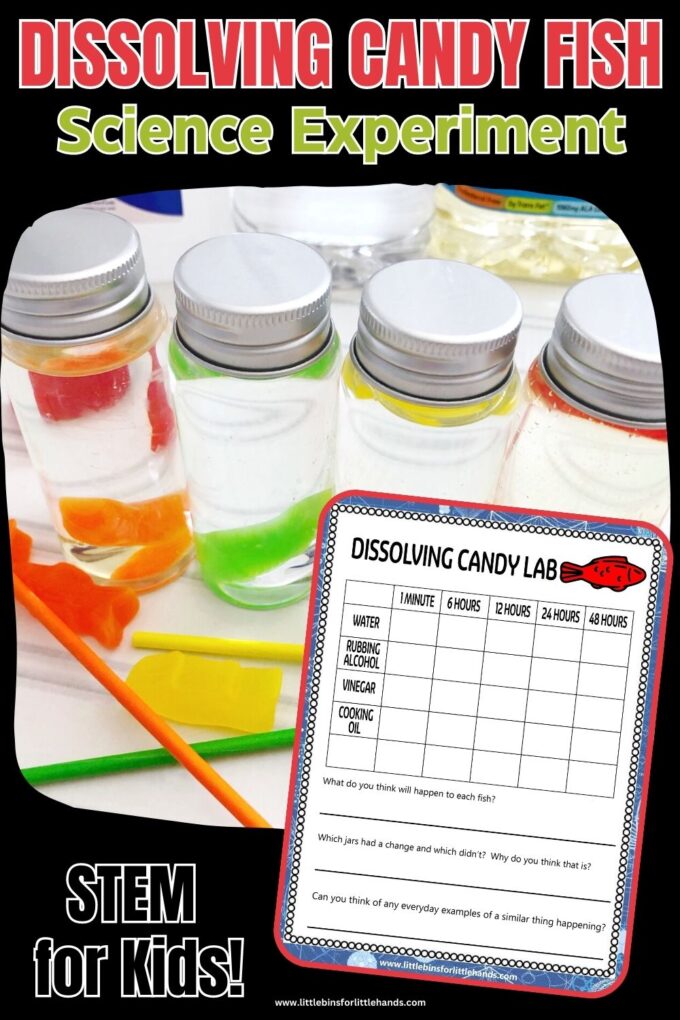
Explore Science With Candy Fish
A fun dissolving candy experiment, all in the name of science and learning! So many simple science experiments are quick and easy to set up for young children. Older children can easily add data collection, graphing, and charts to turn this fun edible science experiment into more of a challenge!
Head into the kitchen to grab your supplies, and let’s find out what happens when you add candy fish to different liquids. Let’s dig in if you want to learn about solutes and solvents!
Exploring solubility is awesome kitchen science. You can raid the pantry for liquids such as water, milk, vinegar, oil, rubbing alcohol, juice, soda or seltzer, and hydrogen peroxide (which we recently used for a very cool hydrogen peroxide and yeast experiment.
Also, check out how we set up this simple dissolving candy experiment with candy canes, candy corn, and candy hearts!
LOOK: 15 Amazing Candy Science Experiments
Growing Gummy Bears
If you love this dissolving candy experiment, check out this growing gummy bears experiment for osmosis.
Let’s get to the supplies and set up for this dissolving fish science activity. Head to the kitchen and open the pantry. Any small jars or clear plastic cups will work!
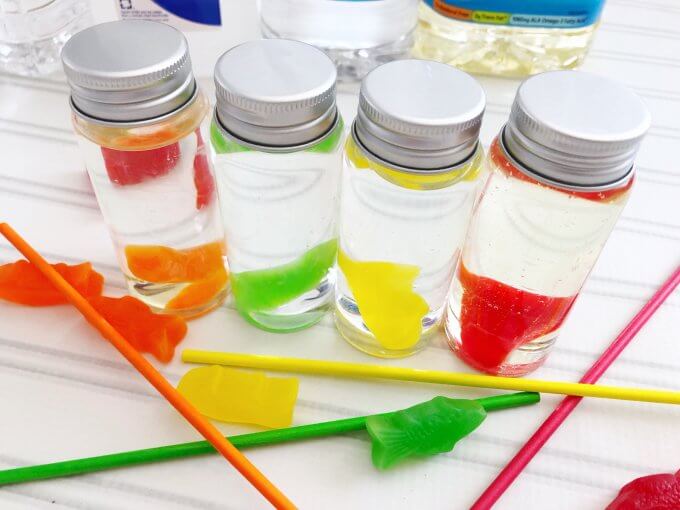
Using The Scientific Method With Kids
The scientific method is a process or method of research. A problem is identified, information about the problem is gathered, a hypothesis or question is formulated from the information, and the hypothesis is put to the test with an experiment to prove or disprove its validity.
Sounds heavy… What in the world does that mean?!?
The scientific method can be used as a guide to help lead the discovery process. You don’t need to try and solve the world’s biggest science questions! The scientific method is all about studying and learning things right around you.
As kids develop practices that involve creating, gathering data evaluating, analyzing, and communicating, they can apply these critical thinking skills to any situation.
To learn more about the scientific method and how to use it. Click here to learn more about the scientific method for kids with examples.
Even though the scientific method feels like it is just for big kids, this method can be used with kids of all ages! Have a casual conversation with younger kiddos, or do a more formal notebook entry with older kiddos (free printable below).
Candy Science Fair Project
Science projects are an excellent tool for older kiddos to show what they know about science! Plus, they can be used in various environments, including classrooms, homeschool, and groups.
Kids can take everything they have learned about using the scientific method, stating a hypothesis, choosing variables, and analyzing and presenting data.
Want to turn this gummy bear osmosis experiment into an awesome science fair project? Check out these helpful resources.
Options To Set Up Your Experiment
There are a few different ways this dissolving candy fish experiment can be set up for kids at home or in the classroom.
FIRST SET UP OPTION: Use one jar of tap water to demonstrate to the class what happens to gummy candy fish in a jar of water over time. This makes a great intro to the overall activity and an obvious prompt for discussion. (See possible questions below.)
SECOND SET UP OPTION: Use different temperature of water in each jar to investigate whether the water temperature affects what happens to the candy fish. This is a good option to use as a small group activity.
THIRD SET UP OPTION: Use a variety of liquids to test which liquid makes a better solvent for sugar (or candy fish). You could use different liquids: water, milk, vinegar, oil, rubbing alcohol, juice, soda or seltzer, and hydrogen peroxide.
Discussion Questions To Ask Students
Before:
- What are all the things you are keeping the same and what one thing are you changing in this experiment?
- What do you think WILL happen to the candy fish when you put them in the jar of water, alcohol, vinegar, oil?
- Will something different happen or will the same thing happen for each jar? (PREDICTION)
During:
- What IS happening to the candy fish?
- Has anything changed in each jar?
- What does the liquid look like now? What do the candy fish look like now? (OBSERVATION)
After:
- Which jars had a change and which didn’t? Why do you think that happened? (EXPLANATION)
- Can you think of any everyday examples when a similar thing happens? (APPLICATION)
Get your FREE printable Candy Science worksheet!
Dissolving Candy Fish Experiment
Also see how we set up this experiment >>> What Can Dissolve In Water
Supplies:
- Gummy Candy Fish
- Small glass or plastic jars
- Warm water
- Rubbing alcohol
- Vinegar
- Cooking oil
- Stir sticks
Instructions:
STEP 1: Place one gummy candy fish in each jar. We used four jars and four different liquids. (See the possible options for this experiment at STEP 2.)
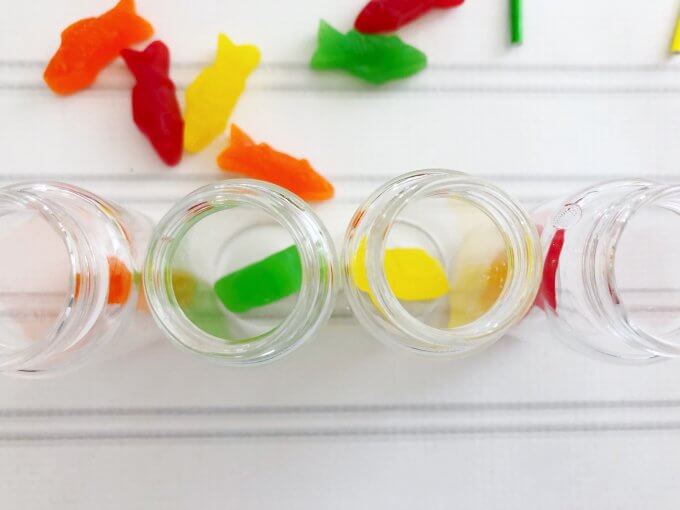
STEP 2: Measure and pour the same amount of different liquids into each jar.
What we used: Orange candy fish – water Green candy fish – alcohol Yellow candy fish – vinegar Red candy fish – cooking oil
Options: You can use water, rubbing alcohol, vinegar, and cooking oil. Additionally, you can try juice, soda, seltzer, or milk! Make sure you note which jar has which in it.
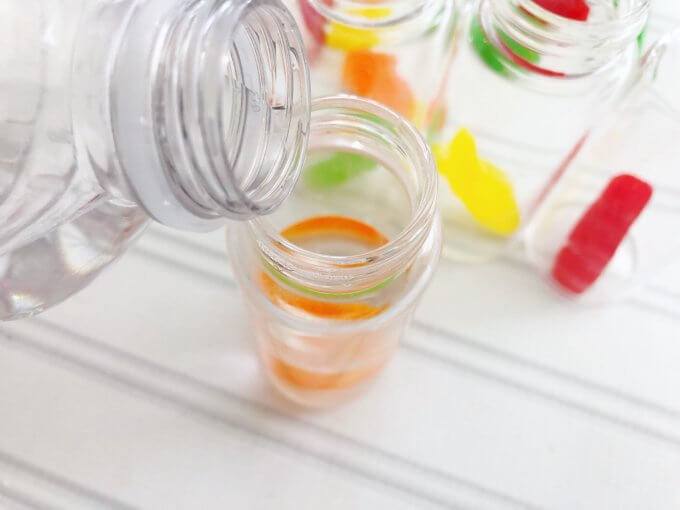
STEP 3: Observe the jars over several hours to see what happens to the candy fish. Alternatively, you can set a specific time allotment and record the results after a set period of time! Or even come back to it the next day.
TIP: This dissolving candy experiment is best if left at least 12 hours to work!
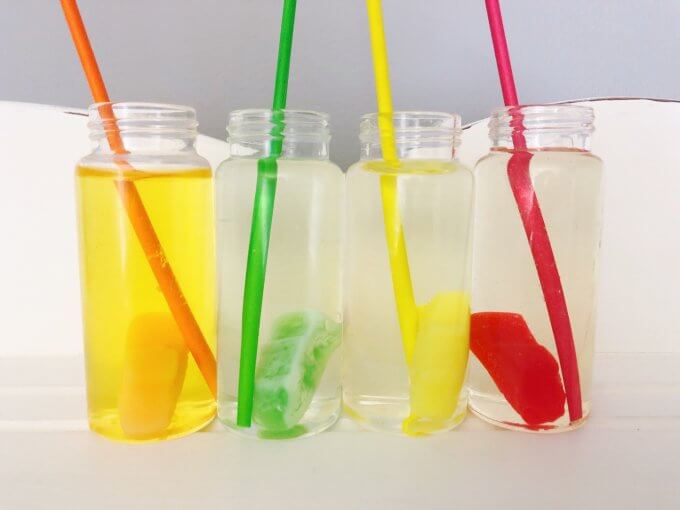
What Happens To Candy Fish In Water?
The main ingredients in gummy candy fish are gelatin, sugar, and flavoring.
When you place gummy candy fish in water, the water moves into them through osmosis since gummy bears don’t contain water. This is an example of physical change!
Osmosis is the process of moving water across a semi-permeable membrane from a low-concentrated solution to a high concentrated solution. A semi-permeable membrane is a thin sheet of tissue or layer of cells acting as a wall that allows only some molecules, like water molecules to pass through.
The semi-permeable membrane in gummy bears is gelatin. The gelatin also stops the gummy fish from dissolving in liquids other than an acidic solution, such as vinegar.
More Fun Candy Science Experiments
- Try a candy taste test with chocolate.
- Why do the colors not mix in this skittles experiment?
- Dissolving candy corn experiment is fun to do!
- Make a coke and mentos eruption!
- What happens when you add pop rocks to soda?
- Try this floating M&M experiment.
Helpful Science Resources
Here are a few resources to help you introduce science more effectively to your kiddos or students and feel confident when presenting materials. You’ll find helpful free printables throughout.
- Best Science Practices (as it relates to the scientific method)
- Science Vocabulary
- 8 Science Books for Kids
- All About Scientists
- Science Supplies List
- Science Tools for Kids
- 50 Easy Science experiments for kids
52 Printable Science Projects For Kids
If you’re looking to grab all of the printable science projects in one convenient place plus exclusive worksheets, our Science Project Pack is what you need!


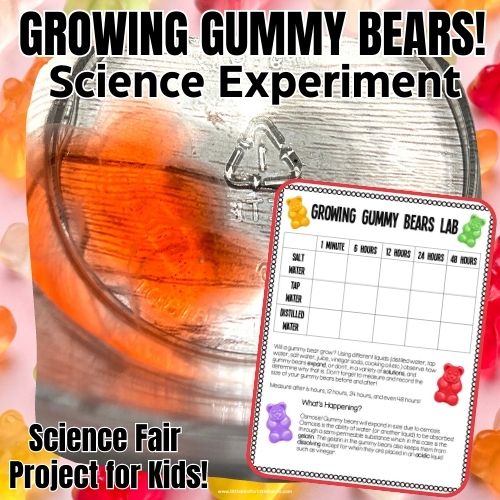
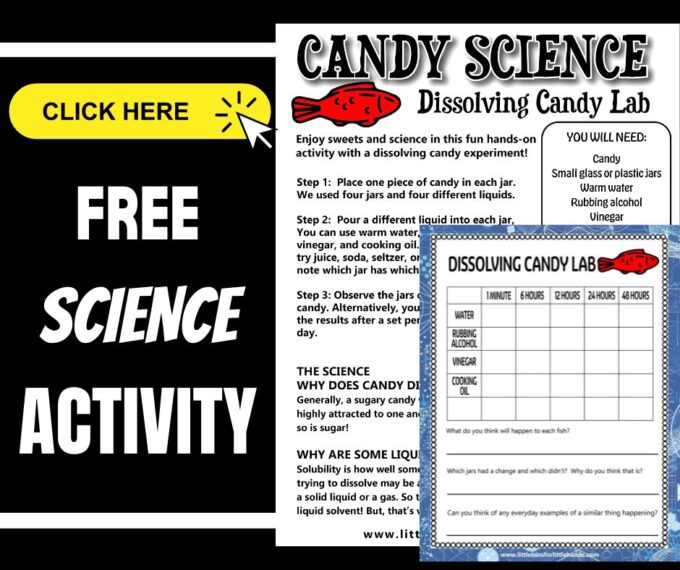
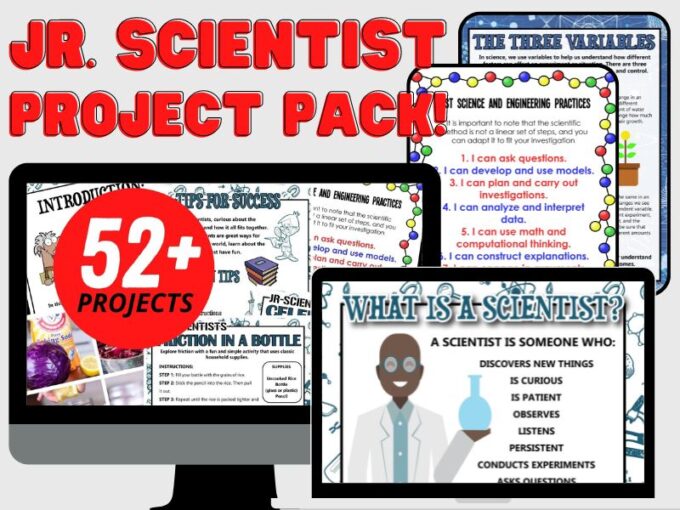






Is this age level appropriate for preschool? How can you differentiate this activity?
You can put these in sealed bottles such as Voss bottles and let the kids explore them dissolving in this fashion. That way they won’t be tempted to taste the experiment. Talk about what you see, let them draw or paint fish. You don’t need a “worksheet” to go with it.